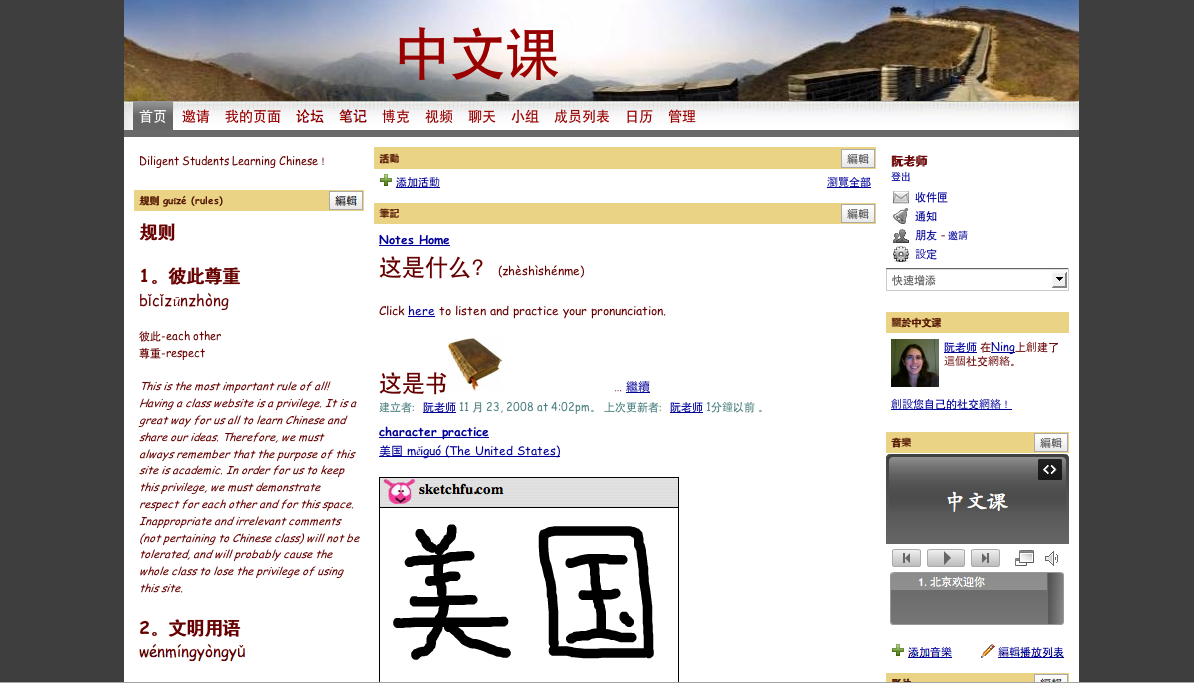A Ning Primer

As many tech integrators have discovered, Ning.com is a good web tool that allows educators to build an ad-free social networking site (e.g. Facebook and MySpace are two of the most popular social networking sites) to supplement their class. The theme of the social network can be the subject area you teach, and the creator controls who can and cannot access the site, in order to ensure a safe learning environment. Overall, Ning brings students together in the virtual world to discuss, explore and contemplate different aspects of a particular class. Here is a breakdown of how Ning can help your teachers make their teaching even more enaging.
Ning in classroom action
With Ning, I created a site for both the Spanish and Chinese classes that I have been teaching this year, in order to allow students to indulge in language and cultural immersion outside of the classroom. Using Ning, I was able to assemble the following:
v A main page to navigate the site
v A profile page for each member (includes for a photo, comments, self introduction and private messaging)
v A space for class notes
v A forum for class discussion
v A blog
v A place for students to chat with each other
v Groups
v Video and photo slideshow support
How can you create a Ning site?
Go to ning.com and sign up for a free account. Pick a name and web address for your social network, and then click on create. Make your site private and password protected. Follow the steps to add the desired features. In order to make certain that the site is ad-free, contact Ning directly, and send a request to remove the ads for your site. In the message, be sure to include your site name, URL, purpose, age of the students (they must be 13 years or older), type of school where you teach and your subject area. Lastly, invite your students to join the network! Be sure to check your school policy regarding participation for such sites. Although the site is password protected, it is probably wise to have your administrator’s approval and obtain written parental consent before sharing the site with students
How can you incorporate Ning into your lessons?
There are a variety of ways to use Ning as a means to have students connect with subject material beyond the classroom. As a foreign language teacher, I set the working language of my websites to Chinese and Spanish, so that students learn how to navigate a website in the target language. Moreover, I intend to have weekly assignments in which students must write information about themselves in the target language, to practice both writing skills and also typing skills (particularly for Chinese). Instead of filling out a grammar worksheet, students get to write about their hobbies, interests, family and other information about themselves on their profile, and comment on each other’s profiles. This is particularly effective in engaging students, because the activity itself is something that they enjoy in English. The only aspect that has changed is the language, which makes language learning more natural and enticing than most traditional methods.
Tools and ideas to transform education. Sign up below.
Ning is also very useful for incorporating supplementary material such as articles, maps and other photos. A good way for students to get involved is to have them take turns posting class notes to the site and also finding additional information related to class themes (i.e. I would encourage my students to find articles discussing cultural topics that interest them to share with the class).
Most students are used to communicating with each other through online social networks such as Facebook and MySpace. Ning.com is just another way for students to connect in this way, and learn content material as they do so.
Allison Riccardi is a MAC (Master of Arts and Certification) candidate at the University of Michigan. She is currently completing her student teaching in Ann Arbor, MI and will be certified to teach Spanish, Chinese and Italian. She holds a passion for world languages and cultures and hopes to inspire her students to utilize technology as a means of traveling the world. Her ultimate goal is to help make students not just citizens of their own community, but also citizens of the world.
